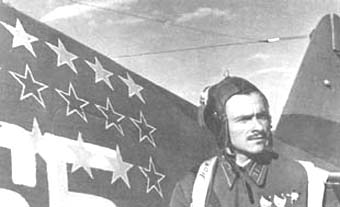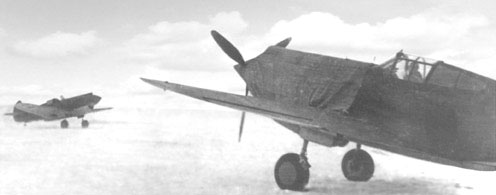
Petr Pokryshev


"Achtung! Curtiss von hinten!" This cry over the air-to-air radio were the last
words ever heard by many German pilots who met the Soviet ace Petr Pokrysev
in the air on the Leningrad front. In successive air combats with the Messerschmitt-
and Focke Wulf-pilots of JG 54 Grünherz, Pokryshev taught the Germans not to
underestimate the Curtiss P-40s that roamed the skies in this area. From 1941
to 1943, he clashed with the Grünherz-Experten - most notably Walter Nowotny
- and proved to be their equal, and on some occasion even more than so. Petr
Afanasevich Pokryshev was one of the most daring and skilful fighter aces on
the Allied side during World War II. On more than 300 missions, leading to 77
aerial combats, he was credited with 38 personal and 8 "collective" victories.
Born in 1914, he took part in the "Winter War" against Finland with the 7th Fighter Regiment (7 IAP). Flying an I-153 biplane, he scored his two first kills against the Finns - but was also himself shot down twice, on November 30, and December 18, 1939. On June 22, 1941, the day when Germany invaded the USSR, Starshiy Leytenant Pokryshev served with 158 IAP, stationed near Leningrad. With his I-16 Ishak, he shot down a Ju 88 reconnaissance plane over Leningrad on June 25, 1941. This was his first kill in the war with the Germans and the second victory ever over that city.
The summer and fall of 1941 were hard times for the Soviet Air Force. Led by Major Hannes Trautloft, the German JG 54 "Grünherz" - the main Luftwaffe fighter unit on the Leningrad front during the entire war - claimed no less than 1,123 Russian aircraft shot down from June to November of that year. Nevertheless, Pokryshev managed to score four victories during August 1941.
Following his successes during the first, difficult months of the war, Pokryshev was assigned as Eskadrilya commander to 154 IAP, which was one of the first Soviet units to be equipped with the Curtiss P-40 Tomahawk Lend-Lease fighters. It was behind the controls of this U.S. made fighter that Pokryshev´s real success rate started. During the winter of 1941/42, the Tomahawks of 154 IAP were entrusted with the fighter cover of the vital "life line" to the starving Leningrad across the frozen surface of Lake Ladoga.
However, it was a hard time, and the fight with the experienced pilots of JG 54 Grünherz was difficult. On January 20, 1942, Kapitan Pokryshev's wingman, Leytenant Andrey Chirkov - another distinguished 154 IAP ace - was shot down by a JG 54 Bf 109.

Tomahawk fighters in Soviet
service, winter 1941/1942.
During 1942, 154 IAP received their first P-40E Warhawks. In June 1942, Petr Pokryshev´s score stood at 11 personal and 7 "collective" victories. During the summer and autumn of 1942, he doubled his score. Not least due to Pokryshev´s feats, 154 IAP was awarded the honoree title "Guards Fighter Regiment" in November 1942, being adopted as 29 GIAP.
His success rate was quite remarkable: during 282 combat missions until February 1943, Pokryshev was involved in a total of 50 air combats, during which he brought down no less than 29 Luftwaffe-planes (7 of them together with other pilots). On February 10, 1943, he was awarded the Golden Star as a token of a Hero of the Soviet Union - the highest Soviet military award. In the spring of 1943, the 29 GIAP's faithful P-40s were delivered to 196 IAP, as the unit was equipped with the new Yak-7 B. In June that year, now promoted to Guards Mayor, Pokryshev took command of the 159 IAP, equipped with La-5s. His own Lavochkin fighter in 29 GIAP, the Yak-7, call-code "33", displaying 30 victory stars, was put on exhibition in Leningrad´s Museum of Defense.
In his last 27 aerial combats, Pokryshev blew another 18 German aircraft out of the sky. On August 24, 1943, he received the title "Double Hero of the Soviet Union". Shortly after that, Mayor Pokryshev was seriously injured. But fate and his skills would not allow any German pilot to put this gallant pilot "out of order". During a training flight on an UTI-4 (a two-seat trainer version of the Polikarpov I-16) together with the pilot Kudryavtsev, the engine suddenly caught fire at an altitude of 400 metres. They tried to reach the airfield, but failed. The ensuing crash put an end to Pokryshev´s fighter career.
Aircraft constructor Aleksandr Yakovlev made a specially prepared Yak-9 for the crippled Pokryshev, and with this he remained in charge of 159 IAP until the end of the war. Under his command, the 159 IAP developed into a very successful Soviet fighter unit, counting among its pilots famous aces such as Vladimir Serov (39 kills)and Viktor Zotov (38 kills). In total, 159 IAP was credited with 387 aerial victories. Petr Pokryshev passed away on August 22, 1967.